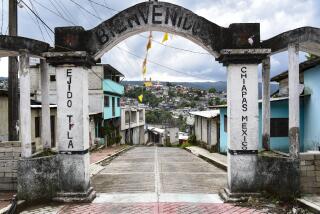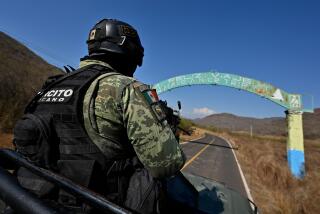Contras Open Major Offensive on Eve of Talks
SANTO DOMINGO, Dominican Republic — About 7,000 Nicaraguan rebels attacked gold-processing centers and military bases Sunday in their largest offensive against the Nicaraguan government, a rebel spokesman here said.
Nicaragua confirmed the attack, which came the day before peace talks between the U.S.-supported Contras and the leftist Sandinista government were to resume in Santo Domingo. A Nicaraguan government official said the talks will go on.
The rebels began hitting targets before dawn in the gold-mining area of Nicaragua’s eastern Zelaya province, said Bosco Matamoros, a spokesman for the rebel umbrella organization called Nicaraguan Resistance.
“Today at 4 a.m. we began the largest military operation of the war with approximately 7,000 of our men, which involves 11 regional commands and 45 task forces,” Matamoros said in an interview.
He said the Contras, who have been fighting for seven years, targeted the towns of Siuna, Rosita and Bonanza and landing strips in the area. He said they aimed to destroy the infrastructure that the government uses for gold processing.
In the Nicaraguan capital, Managua, the official Voice of Nicaragua radio said, “Counterrevolutionary groups launched today at 5 a.m. local time a strong attack against the mining communities . . . and waged heavy fighting.”
However, it said government troops were fighting them off and that only 1,000 rebels were involved. The rebels sustained 10 casualties, according to the radio; it gave no figures for Sandinista casualties.
In Miami, Contra spokesman Jorge Rosales claimed there were at least 100 Sandinista casualties but gave no figure for Contra casualties. Quoting Enrique Bermudez, general commander of the Nicaraguan Resistance, he said the rebels destroyed the radar facility at Siuna and two nearby weapons depots, a power plant, facilities for the airstrips of the three towns, and two bridges between Rosita and Puerto Cabeza, a major Atlantic port.
A top Sandinista government official, speaking on condition of anonymity, said the talks aimed at ending the six-year-old war will go on as planned, however.
“I don’t think this will affect the Santo Domingo thing, because we have not entered into a (truce) commitment. We have no commitment,” the official said. He refused to elaborate.
Zelaya is a remote, jungle-covered province, and reporters are required to get a special permit from the military to visit war areas; these are not readily issued. The three towns are about 280 miles northeast of Managua.
There are no telephones to the area, and communication is by military radio, which is sporadic. The only dirt road to the area is believed to be mined.
The rebels had launched their last big operation in October, when they unsuccessfully tried to cut off the Rama Road, Nicaragua’s main strategic highway, which links the capital with the Zelaya province port of Bluefields on the Caribbean.
Asked why the operation came now, just before peace talks, Matamoros said, “This operation has been planned all along.”
‘Political-Military Conflict’
He said this was “a political-military conflict” to “induce and bring the Sandinistas to the negotiating table.”
“In that area, they transit over 90% of their supplies, ammunition and equipment and fuel for the troops that operate in the northern part of Nicaragua,” he said.
Matamoros said the Sandinistas use landing strips in the area to carry out bombing raids with Soviet-built Antonov 26 aircraft, using 500-pound cluster bombs.
He said the area also includes a Sandinista garrison and general headquarters for state security.
Cardinal Miguel Obando y Bravo, the archbishop of Managua, assisted by Nicaraguan Bishops Bosco Vivas and Carlos Sancti and Father Ariel Arguello, has been acting as mediator between the Contras and the Nicaraguan government.
The two teams of negotiators on each side, including technical advisers, were to discuss details of a truce in the fighting. The Sandinistas already have announced a Christmas cease-fire Dec. 24-25, which the Contras said they will honor.
The Sandinista delegation, headed by Nicaragua’s deputy foreign minister, Victor Hugo Tinoco, is to include an American and a West German as members of a technical advisory commission.
President Daniel Ortega on Friday identified the American as Paul S. Reichler, a Washington attorney who helped Nicaragua sue the United States in the World Court for the mining of Nicaraguan ports in March, 1984.
Hans-Jurgen Wischnewski, the West German, is in charge of international affairs for the West German Social Democratic Party, Ortega said.
Jaime Morales, a millionaire Nicaraguan businessman who lives in Miami, was to head the Contra delegation, according to a rebel source in Florida who spoke on condition of anonymity.
Deadlock in First Meeting
The first meeting here Dec. 2-3 ended in deadlock, mostly because the Sandinistas refused to meet directly with the Contras. Ortega insists that Nicaragua negotiate directly with the United States.
At that meeting, the Sandinistas proposed a 30-day truce in which the rebels would be confined to three areas totaling about 4,000 square miles and would be permitted to receive only food, medicine, clothing and other non-military supplies.
At the end of the cease-fire, rebels would be given the option of rejoining Nicaraguan society or leaving the country, the Sandinistas said.
The Contras countered by demanding that the Sandinistas lift a state of emergency in place since 1982, grant a general amnesty to thousands of political prisoners and guarantee absolute freedom of the press.
The meetings are being held under provisions of a Central American peace agreement signed Aug. 7 by Nicaragua, Honduras, El Salvador, Guatemala and Costa Rica.
More to Read
Sign up for Essential California
The most important California stories and recommendations in your inbox every morning.
You may occasionally receive promotional content from the Los Angeles Times.










